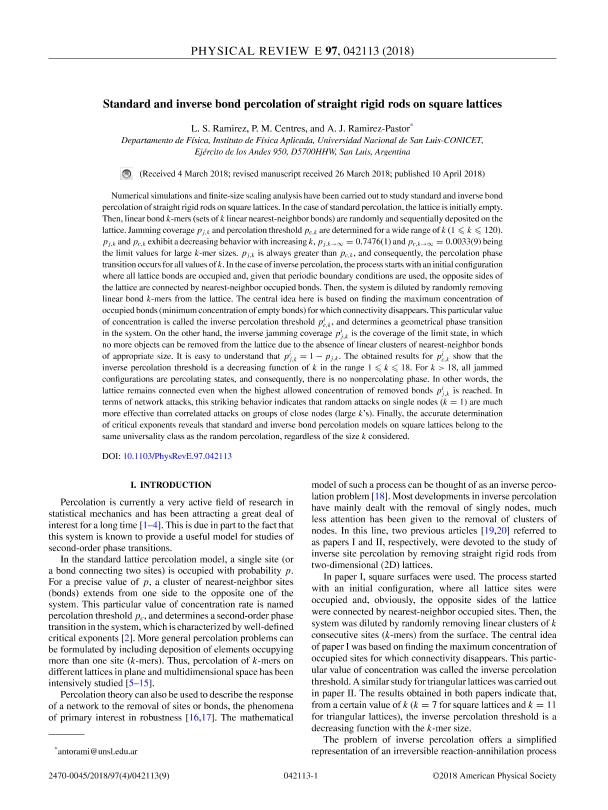Mostrar el registro sencillo del ítem
dc.contributor.author
Ramírez, Lucía Soledad

dc.contributor.author
Centres, Paulo Marcelo

dc.contributor.author
Ramirez Pastor, Antonio Jose

dc.date.available
2019-10-21T18:29:46Z
dc.date.issued
2018-04
dc.identifier.citation
Ramírez, Lucía Soledad; Centres, Paulo Marcelo; Ramirez Pastor, Antonio Jose; Standard and inverse bond percolation of straight rigid rods on square lattices; American Physical Society; Physical Review E: Statistical, Nonlinear and Soft Matter Physics; 97; 4; 4-2018; 42113-42122
dc.identifier.issn
1539-3755
dc.identifier.uri
http://hdl.handle.net/11336/86686
dc.description.abstract
Numerical simulations and finite-size scaling analysis have been carried out to study standard and inverse bond percolation of straight rigid rods on square lattices. In the case of standard percolation, the lattice is initially empty. Then, linear bond k-mers (sets of k linear nearest-neighbor bonds) are randomly and sequentially deposited on the lattice. Jamming coverage pj,k and percolation threshold pc,k are determined for a wide range of k (1≤k≤120). pj,k and pc,k exhibit a decreasing behavior with increasing k, pj,k→∞=0.7476(1) and pc,k→∞=0.0033(9) being the limit values for large k-mer sizes. pj,k is always greater than pc,k, and consequently, the percolation phase transition occurs for all values of k. In the case of inverse percolation, the process starts with an initial configuration where all lattice bonds are occupied and, given that periodic boundary conditions are used, the opposite sides of the lattice are connected by nearest-neighbor occupied bonds. Then, the system is diluted by randomly removing linear bond k-mers from the lattice. The central idea here is based on finding the maximum concentration of occupied bonds (minimum concentration of empty bonds) for which connectivity disappears. This particular value of concentration is called the inverse percolation threshold pc,ki, and determines a geometrical phase transition in the system. On the other hand, the inverse jamming coverage pj,ki is the coverage of the limit state, in which no more objects can be removed from the lattice due to the absence of linear clusters of nearest-neighbor bonds of appropriate size. It is easy to understand that pj,ki=1-pj,k. The obtained results for pc,ki show that the inverse percolation threshold is a decreasing function of k in the range 1≤k≤18. For k>18, all jammed configurations are percolating states, and consequently, there is no nonpercolating phase. In other words, the lattice remains connected even when the highest allowed concentration of removed bonds pj,ki is reached. In terms of network attacks, this striking behavior indicates that random attacks on single nodes (k=1) are much more effective than correlated attacks on groups of close nodes (large k's). Finally, the accurate determination of critical exponents reveals that standard and inverse bond percolation models on square lattices belong to the same universality class as the random percolation, regardless of the size k considered.
dc.format
application/pdf
dc.language.iso
eng
dc.publisher
American Physical Society

dc.rights
info:eu-repo/semantics/openAccess
dc.rights.uri
https://creativecommons.org/licenses/by-nc-sa/2.5/ar/
dc.subject
INVERSE
dc.subject
PERCOLATION
dc.subject
THRESHOLD
dc.subject
JAMMING
dc.subject
PERCOLATION
dc.subject.classification
Física de los Materiales Condensados

dc.subject.classification
Ciencias Físicas

dc.subject.classification
CIENCIAS NATURALES Y EXACTAS

dc.title
Standard and inverse bond percolation of straight rigid rods on square lattices
dc.type
info:eu-repo/semantics/article
dc.type
info:ar-repo/semantics/artículo
dc.type
info:eu-repo/semantics/publishedVersion
dc.date.updated
2019-10-15T14:11:31Z
dc.identifier.eissn
2470-0053
dc.journal.volume
97
dc.journal.number
4
dc.journal.pagination
42113-42122
dc.journal.pais
Estados Unidos

dc.journal.ciudad
Washington DC
dc.description.fil
Fil: Ramírez, Lucía Soledad. Consejo Nacional de Investigaciones Científicas y Técnicas. Centro Científico Tecnológico Conicet - San Luis. Instituto de Física Aplicada "Dr. Jorge Andrés Zgrablich". Universidad Nacional de San Luis. Facultad de Ciencias Físico Matemáticas y Naturales. Instituto de Física Aplicada "Dr. Jorge Andrés Zgrablich"; Argentina
dc.description.fil
Fil: Centres, Paulo Marcelo. Consejo Nacional de Investigaciones Científicas y Técnicas. Centro Científico Tecnológico Conicet - San Luis. Instituto de Física Aplicada "Dr. Jorge Andrés Zgrablich". Universidad Nacional de San Luis. Facultad de Ciencias Físico Matemáticas y Naturales. Instituto de Física Aplicada "Dr. Jorge Andrés Zgrablich"; Argentina
dc.description.fil
Fil: Ramirez Pastor, Antonio Jose. Consejo Nacional de Investigaciones Científicas y Técnicas. Centro Científico Tecnológico Conicet - San Luis. Instituto de Física Aplicada "Dr. Jorge Andrés Zgrablich". Universidad Nacional de San Luis. Facultad de Ciencias Físico Matemáticas y Naturales. Instituto de Física Aplicada "Dr. Jorge Andrés Zgrablich"; Argentina
dc.journal.title
Physical Review E: Statistical, Nonlinear and Soft Matter Physics

dc.relation.alternativeid
info:eu-repo/semantics/altIdentifier/url/https://journals.aps.org/pre/abstract/10.1103/PhysRevE.97.042113
dc.relation.alternativeid
info:eu-repo/semantics/altIdentifier/doi/http://dx.doi.org/10.1103/PhysRevE.97.042113
Archivos asociados
